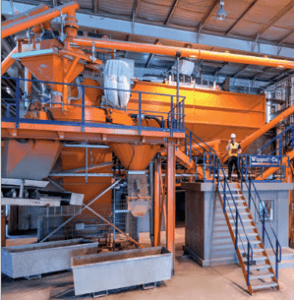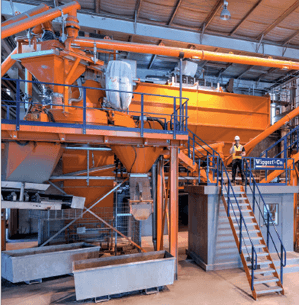 Modernized Jessup plant strengthens Concrete Pipe & Precast’s regional position
Modernized Jessup plant strengthens Concrete Pipe & Precast’s regional position
In February, Concrete Pipe & Precast, LLC, based in Ashland, Virginia, USA, fired up a new, automated batching system at its Jessup, Maryland, plant. The 70,000 square foot production facility experienced an equipment failure in its aging batch plant last October. “Thankfully, the breakdown occurred at the beginning of the winter, which is typically a slower period and that gave us an opportunity to rebuild it with many improvements” notes John Blankenship, CP&P operations manager. CP&P was formed in 2012 as a joint venture between Americast and Hanson Pipe & Precast to provide the competitive Mid-Atlantic region with a complete line of concrete pipe and precast products. “We used ready mix until we could get back on our feet. It did the job, but I would not wish that experience on anyone.”
The Jessup plant, one of 13 in the CP&P portfolio, was built in the 1950s and produces approximately 500 tons a day of round and horizontal elliptical concrete pipe, ranging in size from 15 inch (381mm) to 72 inch (1800mm) diameter, in profile and o-ring gasket joint styles. The plant also produces flared end sections, a range of box culverts sizes, and specially designed pipe for jacking, deep fills, and lined sewer pipe.
Pipe production systems at Jessup include the HawkeyePedershaab PipePlusPlus, PipePro XT, Single Station Model 144 VUP large pipe system, and ROCO and VROC automated product and ring handling systems. Prior to October 2014, the plant relied on two horizontal ribbon mixers located at the base of a 110-foot tall batching tower.
A batch of challenges
The original batching system relied on gravity to batch mix components down to the mixers. The height of the batching structure made it difficult to maintain the system and the manual nature of the operation made it highly labor intensive.
“We needed a full time operator and it took four or five staff to clean the mixers after every shift,” says Blankenship. “The biggest problem we had with our old mixers was reliability and mix consistency. It was essentially manual control and therefore we were continually having to adjust flow rates and settings to meet acceptable concrete batch tolerances.”
While the Jessup plant relied on a proven mix design, the battle to get the water/ cement ratio just right, combined with man- ual batch operation, led to under yielding and high cement usage, which frequently resulted in quality problems.
“If the mix was too wet or too dry, the result was waste,” explains Blankenship. “The pipe has to cure overnight before we can remove the spigot ring and bell pallet. If the mix is too dry we run the risk of under filling, and if the mix is too wet you get wall slump/ripples and develop circumferential cracking. The result is rejects and waste.”
Focus on commitment
Of course, no company ever wants to experience a major equipment breakdown, but in the case of the Jessup plant, this came at an “opportune” moment of sorts. CP&P, the product of a joint venture and multiple acquisitions, was just about to launch a company-wide quality improvement and identity building program—“Commitment 2016”.
A key focus of the new program is to provide customers with “relentless platinum grade quality” in products and services. The Commitment 2016 program roll-out started in January at all 13 CP&P plants. The firm’s Commitment 2016 committee provides ongoing guidance and direction to help each plant to develop and implement processes and practices that will ensure platinum grade quality.
The selection of a new batching system for the Jessup plant took on new importance in light of the Commitment 2016 program. The selection team considered several proposals from leading batch system providers.
Past experience guides decision
“We are committed to our customers and meeting their needs and that requires a reliable, highly consistent batching system,” Blankenship emphasizes. “We already had extensive experience with batch plants from Advanced Concrete Technologies (ACT). We have installed eight of them across CP&P and other companies I’ve been associated with.” Blankenship, a 30-year industry veteran, notes that it was initially difficult for him to accept the approach used by ACT and its German partner, Wiggert & Company. “My early experience in this industry was with a company where we built much of the equipment ourselves,” Blankenship says. “We did not buy complete, turnkey systems. We’d buy the parts and put them together or fabricate our own conveyors, hoppers and mixer platforms, for example.”
Over the years, Blankenship’s opinion of ACT/Wiggert’s approach—pre-wired, factory tested, turnkey batch plants—evolved. “Having installed and used several ACT/ Wiggert plants in the last 12 years, I’ve come to appreciate that there are many advantages to their methodology,” he observes. “The standardization and best-in-class approach means we get a batch plant that not only produces high quality con- crete consistently and reliably, but when we do need service it’s easy to get and parts are readily available. They know their sys- tems so well because of the fact that their designs are modular and use similar standardized components.”
Jessup batch plant installation includes a low-profile 195-ton three-compartment aggregate storage system, including weigh belt conveyor, from ACT/Wiggert. Hydrotester moisture sensors located below each aggregate bin, combined with microwave probes in each mixer, enable the PCS control system to consistently and accurately maintain the correct water/cement ratio for every batch.
One of two mixer platforms, each equipped with an ACT/Wiggert HPGM 2250 two-cubic-yard (1500L) planetary countercurrent mixer, receive aggregates from a skip hoist (left) and cement and fly ash screws (right). Each mixer is equipped with two discharge gates, one for dry cast and one for wet cast and clean out using an automated high pressure mixer cleaning system.
ACT engineers visited the Jessup plant in early November 2014, just a few days after the batch plant breakdown to assess the situation and begin to design a new plant that would fit into the existing plant infrastructure. The Jessup production team wanted the new batching system to fit inside the existing building for all-weather operation and easier maintenance.
As the Jessup plant was relying on ready mix deliveries to meet its production needs, the company needed the new ACT/Wiggert batch plant in shortest possible delivery time. Wiggert was able to shift production at its factory in Germany and accommodate the rush order almost immediately. The plant was produced, tested and delivered within six weeks of the order.
Read Full CP&P Jessup Plant Press Release










